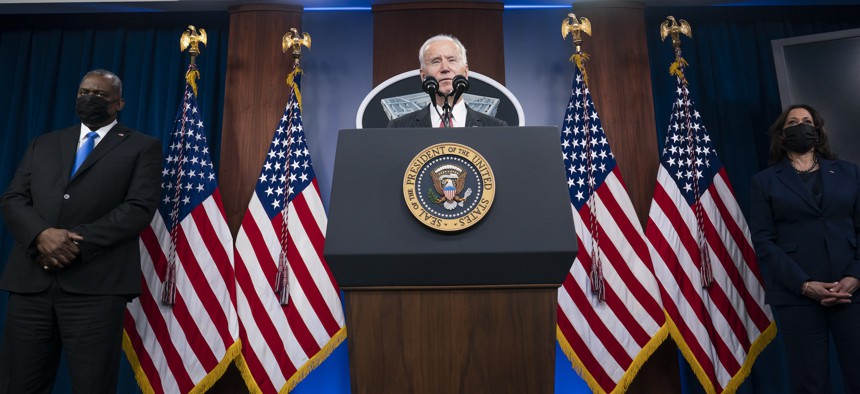Biden’s $715B Defense Ask: Higher Than Expected, Lower than Trump’s Plan
“Skinny budget” announcement hints at cuts to troop levels and existing weapons.
The Biden administration pledged to spend billions of dollars on nuclear weapons, long-range weapons, and emerging technologies to counter China, but hinted that it would propose cuts to existing weapons and troops.
The White House on Friday announced its defense spending priorities within a $1.52 trillion federal budget proposal. The long-awaited “skinny budget” announcement lacks details about specific programs but calls generally for upping spending on education, health care, and climate change.
Officials announced a proposed Defense Department topline of $715 billion, which would be a non-inflation-adjusted increase of 1.4 percent from the $705 billion Congress appropriated in fiscal 2021. When other defense-related spending at the Energy Department and elsewhere is factored in, the administration’s total national defense budget request totals $763 billion, about 1.7 percent higher than the $740 billion Congress appropriated this year.
“A large chunk of that increase is...the pay raise for men and women and troops in uniform, and then the civilians that support them,” an administration official told reporters Friday. “The focus [of the federal budget] will be on investment on non-defense but also ensuring the Defense Department can continue its strategic goals as we out compete China and as we ensure that the men and women in uniform have everything that they need.”
Progressive Democrats say the request is too high. Republican defense hawks say it’s not enough. Wall Street analysts say it is good enough.
Defense watchers have long projected a flat Pentagon budget at best, no matter who won last year’s presidential election. A spending plan left behind by the Trump administration called for a $722 billion Pentagon budget in fiscal 2022, a figure first reported by Defense One in December. That was far lower than the 3 to 5 percent annual increase championed by former Defense Secretary Jim Mattis and other top military officials.
Current Deputy Defense Secretary Kathleen Hicks, who is overseeing the Pentagon’s budget request, was on a bipartisan commission that in 2018 recommended a 3 to 5 percent annual increase in defense spending.
“As we’ve said before, a flattish number would be positive because the Biden Admin will be signaling to Congress that it doesn't want big cuts in defense,” Cowen & Company analyst Roman Schweizer said in a Friday note to investors. “That would displease both Democrat liberal-progressives (who want big cuts) and GOP defense hawks (who want +3-5% annual growth). In Washington, when both sides are angry, that's called a compromise. There will be a lot of griping along the way, but it's the kind of outcome that probably makes sense.”
The spending figures announced Friday prioritize “the need to counter the threat from China as the Department’s top challenge,” according to White House budget documents. “The Department would also seek to deter destabilizing behavior by Russia.”
The request also talks about “leveraging the Pacific Deterrence Initiative” a budget account created to deter China and working with allies in the Indo-Pacific and across NATO.
“The pursuit of our national security interests requires investments that target and align our priorities and capabilities to address the constantly evolving and dynamic threat landscape,” Defense Secretary Lloyd Austin said in a Friday morning statement. “The President’s discretionary funding request represents an important investment that will ensure the Department’s resources are matched with our strategy and policy to defend the nation and take care of our people, while revitalizing the key alliances and partnerships to succeed.”
Like the Obama and Trump administrations, Biden plans to continue investing in new technology.
The “request prioritizes defense research, development, test, and evaluation funding to invest in breakthrough technologies that would drive innovation and underpin the development of next-generation defense capabilities,” the document states.
The Biden administration also said it would make “executable and responsible investments in the U.S. Navy fleet.” The Trump administration had called for a massive increase in navy ships viewed as unaffordable in the long term.
The documents also pledged “recapitalization of the Nation’s strategic ballistic missile submarine fleet,” and investments “in remotely operated and autonomous systems and the next generation attack submarine program.” It also said the spending request “maintains a strong, credible nuclear deterrent for the security of the Nation and U.S. allies.
“While the Administration is reviewing the U.S. nuclear posture, the discretionary request supports ongoing nuclear modernization programs while ensuring that these efforts are sustainable,” the documents state.
It appears cuts to troop levels and older weapons would be proposed to make up for the $7-billion gap between the Trump and Biden proposals.
“The discretionary request supports DOD’s plan to divest legacy systems and programs to redirect resources from low- to high-priority programs, platforms, and systems,” the document states. “Some legacy force structure is too costly to maintain and operate, and no longer provides the capabilities needed to address national security challenges. The discretionary request enables DOD to reinvest savings associated with divestitures and other efficiencies to higher priority investments.”
Army Chief of Staff Gen. James McConville, recently said he wants more troops, but would instead look for cheaper ways to train because he also needs new weapons.
The “request invests in the development and testing of hypersonic strike capabilities while enhancing existing long-range strike capabilities to bolster deterrence and improve survivability and response timelines,” the budget document states.
Both the Air Force and Army are investing in new long-range strike weapons.
The budget also eliminated the Overseas Contingency Operations account originally created for war funding, but more recently used both the Obama and Trump administrations to circumvent defense spending caps over the past decade. This is the first budget not constricted by those caps.
“Both sides of the aisle considered Overseas Contingency a budgetary gimmick given that many of the overseas operations that they supported have been around for many, many years,” the administration official said. We had bipartisan interest in ensuring that those things were accomplishing the baseline budget.”






